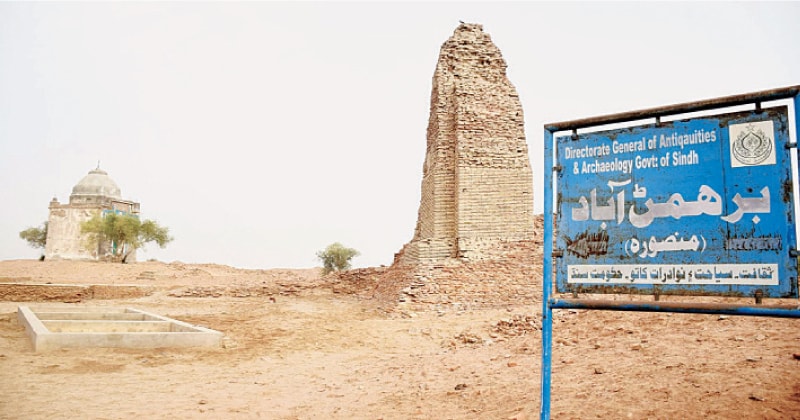
AS a cool breeze blew across, the only sound at the ancient ruins was a Sindhi song a tractor driver was playing at a high pitch. He was ploughing a field near the historic site of Mansura, earlier known as Brahmanabad, some 18km southeast of Shahdadpur.
I actually wanted to visit Achhro Thar in Sanghar’s arid region, but my mate Zafar Mangi suggested that we go instead to the site of Mansura, the first capital established by the Muslims in the subcontinent after Mohammad bin Qasim seized the Brahmanabad territory.
Coming from Hyderabad via the Tando Adam road, we took a left turn to hit a katcha path surrounded by agriculture fields that led us to the site. Joining us on this trip to the ruins having a circumference of about 6.4km was Nawaz Kumbhar, a writer.
Excavations at the site between 1966 and 1998 were overseen by the federal government. Recently some excavation work was conducted under the supervision of the Sindh government as subject of antiquity was devolved to provinces in line with the provisions of the 18th Amendment.
Mansura or Brahmanabad, which some experts say once boasted vast orchards of mangoes and date palms, is at the centre of a debate among archaeologists. According to Sindh culture department, Henry Cousens — considered the doyen of Sindhi archaeology — after an excavation in 1920 wrote: “No ancient site in western India has given rise to more controversy… than that which has been known as Brahmanabad”.
Brahmanabad looked like a fortified settlement with four gates. The first phase of the recent excavation — carried out between Dec 8 and Jan 15 — was supervised by Prof Ghulam Mohiuddin Veesar of the Shah Abdul Latif University, Khairpur, and conducted by his team of archaeologists.
Prof Veesar, who has also worked on the ancient sites of Mehrgarh and Harappa with American archaeologists, finds Mansura equally exciting insofar as archaeological evidence is concerned. An elevated surface is visible on its eastern portion where a courtyard that is 150 feet wide (north to south) and 250 feet long (east to west) exists. This has been described as a mosque.
“We have to have more (such) exercises. Nine trenches of 5ft by 5ft were dug up, revealing the site’s chronology dating back to 2nd to 13th centuries AD,” he says. “Mansura was also home to people of other creeds before (Mohammad bin) Qasim established it, marking commencement of the Islamic period. It was known as Brahmanabad before,” he adds.
At the site, Prof Veesar found artefacts like shells used in bangle-making; such bangles are worn by Thari women even today. People of Brahmanabad, he believes, were well-off. They used to deal in precious stones brought from other regions and processed here.
There is evidence to show the area had proper town planning, which is reflected in one-metre-thick walls and easily distinguishable streets. Walls were made of burnt bricks. “The upper surface indicates Qasim’s period while the second surface points to existence of non-Muslim settlement of Brahmanabad prior to him,” he says.
Historical accounts show that Brahmanabad fell to Mohammad bin Qasim, who went on a conquest spree in the region.
Chachnama — the early and authenticated reference to Sindh’s history that was written in Arabic and translated into Persian by Ali Kufi in the seventh Hijra — says Rai Siharas ruled Sindh in the pre-Islamic era and its capital was Arore. Rai’s son, Sahasi, succeeded him after his death in a battle with Iranians. Sahasi later came across Chach bin Seelaj, a Brahmin, and appointed him in his cabinet. After Sahasi’s death, his widow Sohnan Devi married Chach. They had two sons, Raja Dahar and Daharseena, and a girl, Maheen.
Chach’s rule spanned over 40 years and he defeated Brahmanabad’s ruler, Agham. After his death, Chach’s brother Chandar ruled for seven years. Raja Dahar ruled Arore and Daharseena Brahmanabad before Bin Qasim led the Muslim conquest of Sindh.
Reverting to the excavation work, it was carried out vertically so as to have chronology. Archaeologists consider potteries as important pieces of evidence at any site. Potteries at Mansura have images of human forms and figures of elephant and snake etc. This polychrome pottery also has birds and animals indicating the Buddhist era between 3AD and 7AD, says Prof Veesar.
He believes the pottery is identical to that of the period when Chandragupta Maurya was emperor, as the ancient site of Rang Mahal in north India (from 2nd century AD) indicates the same chronology. Copper coins with Kufic script were also found. Moulds used for coin-making have been found in large numbers.
From the culture department’s point of view, the excavation work is aimed at discovering various phases of life associated with the heritage site. The department plans to establish a museum here to preserve and display artefacts, figurines and other items recovered from the site.
Sindh Culture Minister Syed Sardar Ali Shah plans to give the go-ahead for a second phase of excavation work at Mansura in November as he believes winter is suitable for such work. “This work was long overdue for conservation purposes,” says Mr Shah, who is also a poet with keen interest in literature and heritage.
However, his department faces a dilemma as it does not have mutations of land records involving heritage sites. That is why it intends to club together the Heritage Act 1974 and Sindh Cultural Heritage (Preservation) Act 1994 to have a single comprehensive law governing everything including demarcation and mutation of such sites in the department’s name.
The minister says ancient sites need be protected in line with best conservation practices. But until that objective is achieved, potential encroachers will keep staring at these assets with greed.
Published in Dawn, April 12th, 2021














































